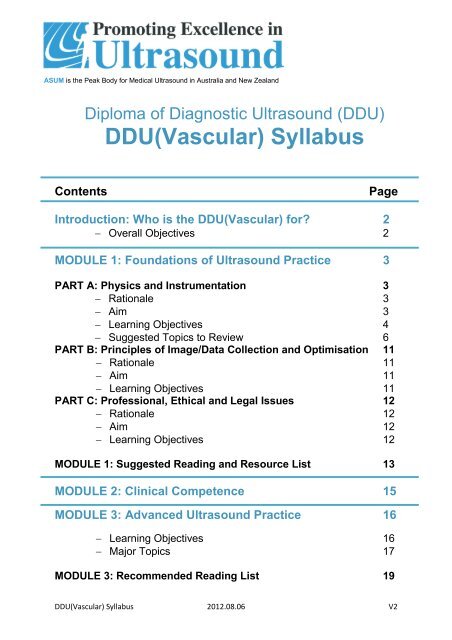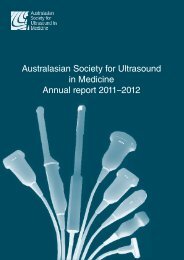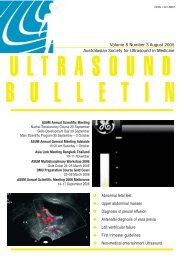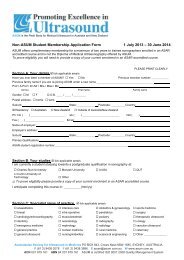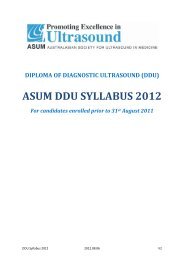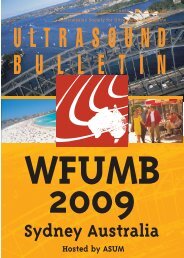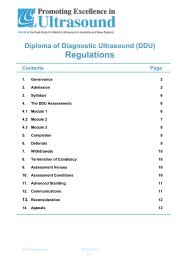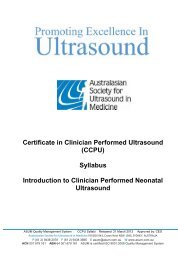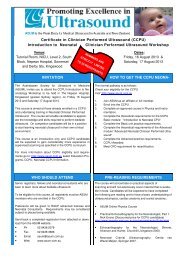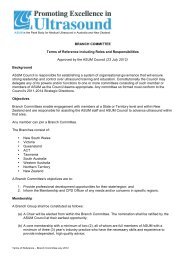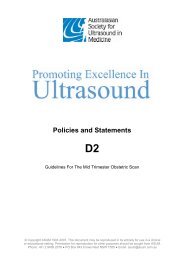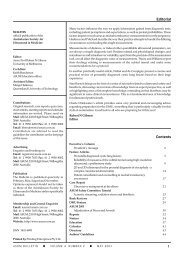DDU(Vascular) - Australasian Society for Ultrasound in Medicine
DDU(Vascular) - Australasian Society for Ultrasound in Medicine
DDU(Vascular) - Australasian Society for Ultrasound in Medicine
- No tags were found...
You also want an ePaper? Increase the reach of your titles
YUMPU automatically turns print PDFs into web optimized ePapers that Google loves.
ASUM is the Peak Body <strong>for</strong> Medical <strong>Ultrasound</strong> <strong>in</strong> Australia and New ZealandDiploma of Diagnostic <strong>Ultrasound</strong> (<strong>DDU</strong>)<strong>DDU</strong>(<strong>Vascular</strong>) SyllabusContentsPageIntroduction: Who is the <strong>DDU</strong>(<strong>Vascular</strong>) <strong>for</strong>? 2− Overall Objectives 2MODULE 1: Foundations of <strong>Ultrasound</strong> Practice 3PART A: Physics and Instrumentation 3− Rationale 3− Aim 3− Learn<strong>in</strong>g Objectives 4− Suggested Topics to Review 6PART B: Pr<strong>in</strong>ciples of Image/Data Collection and Optimisation 11− Rationale 11− Aim 11− Learn<strong>in</strong>g Objectives 11PART C: Professional, Ethical and Legal Issues 12− Rationale 12− Aim 12− Learn<strong>in</strong>g Objectives 12MODULE 1: Suggested Read<strong>in</strong>g and Resource List 13MODULE 2: Cl<strong>in</strong>ical Competence 15MODULE 3: Advanced <strong>Ultrasound</strong> Practice 16− Learn<strong>in</strong>g Objectives 16− Major Topics 17MODULE 3: Recommended Read<strong>in</strong>g List 19<strong>DDU</strong>(<strong>Vascular</strong>) Syllabus 2012.08.06 V2
<strong>DDU</strong>(<strong>Vascular</strong>) SyllabusIntroduction: Who is the <strong>DDU</strong>(<strong>Vascular</strong>) <strong>for</strong>?A <strong>DDU</strong> certified doctor is a specialist medical practitioner who has overall responsibility<strong>for</strong> ensur<strong>in</strong>g the most accurate and valid <strong>in</strong><strong>for</strong>mation possible is obta<strong>in</strong>ed from theultrasound exam<strong>in</strong>ation. The <strong>DDU</strong> holder is then responsible <strong>for</strong> us<strong>in</strong>g the acquired<strong>in</strong><strong>for</strong>mation to mean<strong>in</strong>gfully contribute to cl<strong>in</strong>ical patient management. The <strong>DDU</strong> holderwould usually have diagnostic ultrasound as a major focus of their practice and acceptreferrals from a range of other medical practitioners as well as self-referrals.The <strong>DDU</strong> holder has detailed specialist level knowledge and skill <strong>in</strong> all aspects of thediagnostic ultrasound process. This knowledge and skill may also apply to therapeutic<strong>in</strong>terventions/processes.Candidates <strong>for</strong> the <strong>DDU</strong> (<strong>Vascular</strong>) would usually be specialist medical practitioners whohave a special <strong>in</strong>terest and expertise <strong>in</strong> all aspects of vascular diagnosis with a particularemphasis on ultrasound. It is expected that candidates would be work<strong>in</strong>g predom<strong>in</strong>antly<strong>in</strong> the area of vascular ultrasound and be able to develop <strong>in</strong>-depth knowledge andexperience suitable <strong>for</strong> specialist level referral practice <strong>in</strong> vascular diagnosis andultrasound.OVERALL OBJECTIVESMODULE 1: Foundations of <strong>Ultrasound</strong> PracticeOn completion of this module of study you will have demonstrated your knowledge of:• Physics and <strong>in</strong>strumentation• Pr<strong>in</strong>ciples of image/data collection and optimisation• Professional, ethical and legal issuesby successfully complet<strong>in</strong>g a written assessment.MODULE 2: Cl<strong>in</strong>ical CompetenceOn completion of this module of study you will have demonstrated scann<strong>in</strong>g anddiagnostic competence by successfully undertak<strong>in</strong>g and complet<strong>in</strong>g:• Five (5) Case Studies• Five (5) Cl<strong>in</strong>ical Supervisor Assessments• A logbook of specified scansMODULE 3: Advanced <strong>Ultrasound</strong> PracticeOn completion of this module of study you will have demonstrated your theoreticalknowledge and advanced diagnostic and practical skills by successfully undertak<strong>in</strong>g andcomplet<strong>in</strong>g:• A written assessment• An oral assessment2
<strong>DDU</strong>(<strong>Vascular</strong>) SyllabusLEARNING OBJECTIVESPhysical pr<strong>in</strong>ciples of ultrasoundCandidates will be able to describe:• the wave nature of ultrasound and its propagation through tissue.• the reflection and scatter<strong>in</strong>g of ultrasound and relate these to acoustic impedance.• the concept of attenuation, its mechanisms and factors affect<strong>in</strong>g it.• refraction of ultrasound and critical angle of <strong>in</strong>cidence.• the concept of pulsed ultrasound.• the concept of the bandwidth of an ultrasound pulse.Transducer and beam<strong>for</strong>m<strong>in</strong>g conceptsCandidates will be able to describe the:• purpose and function of a transducer and the construction of a typical transducer.• concept of an ultrasound beam and the importance of controll<strong>in</strong>g beam width.• beam shape <strong>for</strong> a simple unfocused transducer.• various methods used to focus the beam, <strong>in</strong>clud<strong>in</strong>g electronic focuss<strong>in</strong>g <strong>for</strong> arraytransducers.• major types of transducer and the mechanisms used with each to scan the beamwhen imag<strong>in</strong>g.• concept of slice thickness.Candidates will be able to:• def<strong>in</strong>e beam sidelobes.• expla<strong>in</strong> the factors affect<strong>in</strong>g the choice of transducer <strong>for</strong> a specific application.Imag<strong>in</strong>g pr<strong>in</strong>ciples and technologyCandidates will be able to describe the:• pulse-echo pr<strong>in</strong>ciple and how it is used <strong>in</strong> B-mode and M-mode ultrasound imag<strong>in</strong>g.• basic components of an ultrasound imag<strong>in</strong>g mach<strong>in</strong>e and their purpose.• controls associated with each component and their effect on the image.• methods used to make measurements from images.• various methods available to record imagesCandidates will be able to:• def<strong>in</strong>e the major aspects of image quality.• recognise the pr<strong>in</strong>cipal image artifacts and describe how they are produced andhow they can be identified and/or elim<strong>in</strong>ated.4
<strong>DDU</strong>(<strong>Vascular</strong>) SyllabusDoppler pr<strong>in</strong>ciples and <strong>in</strong>strumentationCandidates will be a able to describe the:• pr<strong>in</strong>ciple of operation and components of cont<strong>in</strong>uous wave and pulsed Doppler<strong>in</strong>strumentation.• elements of the Doppler spectral display and how it is used to make measurements.• pr<strong>in</strong>ciple of operation and components of colour Doppler.• <strong>in</strong>strumentation, <strong>in</strong>clud<strong>in</strong>g power (amplitude) mode.Candidates will be able to:• expla<strong>in</strong> the Doppler effect and describe how it is used <strong>in</strong> ultrasound diagnosis.• recognise the pr<strong>in</strong>cipal Doppler artifacts and describe how they are produced andhow they can be identified and/or elim<strong>in</strong>ated.Bioeffects and safetyCandidates will be able to:• demonstrate an understand<strong>in</strong>g of the potential <strong>for</strong> bioeffects and biohazards.• def<strong>in</strong>e the parameters used to characterise patient exposure.Candidates will be able to expla<strong>in</strong>:• the known thermal and mechanical bioeffects and the relative likelihood of theseoccurr<strong>in</strong>g with different modes of exam<strong>in</strong>ation.• practical approaches to reduc<strong>in</strong>g risk and relevant ASUM policies.New and evolv<strong>in</strong>g techniques• Candidates will be able to discuss briefly the basic pr<strong>in</strong>ciples <strong>in</strong>volved <strong>in</strong> a range ofnew technologies <strong>in</strong>clud<strong>in</strong>g:- multiple beam<strong>for</strong>m<strong>in</strong>g- extended field of view- contrast agents- tissue and contrast harmonic imag<strong>in</strong>g- spatial compound scann<strong>in</strong>g- three dimensional (and 4D) scann<strong>in</strong>g- coded signals- Doppler tissue imag<strong>in</strong>g- elastography.5
<strong>DDU</strong>(<strong>Vascular</strong>) SyllabusSUGGESTED TOPICS TO REVIEWPhysical pr<strong>in</strong>ciples of ultrasoundDescribe:Calculate:- frequency, wavelength, period- propagation speed- amplitude, energy, power, <strong>in</strong>tensity- attenuation, relationship between frequency and penetration- acoustic impedance- reflection, scatter<strong>in</strong>g- refraction, critical angle- pulsed ultrasound, pulse repetition frequency, pulse duration- relationship between period and frequency: =- relationship between frequency, wavelength & propagation speed:- <strong>in</strong>tensity: = λ = - attenuation as a function of tissue type, frequency and distance = × × - <strong>in</strong>tensity reflection coefficient: = − ² + ² × %- refraction us<strong>in</strong>g Snell’s Law: = - ga<strong>in</strong> and attenuation us<strong>in</strong>g decibel notation6
<strong>DDU</strong>(<strong>Vascular</strong>) SyllabusTransducer and beam<strong>for</strong>m<strong>in</strong>g conceptsDescribe:Calculate:- piezoelectric effect, transducer resonance- transducer construction, back<strong>in</strong>g and match<strong>in</strong>g, coupl<strong>in</strong>g gel- transducer bandwidth, relationship to pulse duration- broadband transducers- unfocussed transducer beam pattern, near and far fields- focuss<strong>in</strong>g us<strong>in</strong>g lens or curved transducer- focussed transducer beam pattern- weak, medium and strong focus<strong>in</strong>g- array transducer construction- electronic focuss<strong>in</strong>g us<strong>in</strong>g array transducers- electronic beam steer<strong>in</strong>g- sidelobes, slice thickness- variation of <strong>in</strong>tensity with depth and across width of beam- major probe types - l<strong>in</strong>ear, curved and phased arrays- scan patterns of major probe types- factors affect<strong>in</strong>g choice of transducer <strong>for</strong> given application- transition distance (near field length): = λ- far field divergence: = . λ- beamwidth at focus (of focussed transducer) =. λImag<strong>in</strong>g pr<strong>in</strong>ciples and technologyDescribe:- pulse echo concept (relationship between echo time and depth)- image <strong>for</strong>mation, B and M-mode- function, purpose and associated controls of:• transmitter• beam<strong>for</strong>mer7
<strong>DDU</strong>(<strong>Vascular</strong>) Syllabus• amplifier, TGC• digitisation• dynamic range compression• scan converter• pre-process<strong>in</strong>g• image memory• post-process<strong>in</strong>g• display- mean<strong>in</strong>g of term ‘artifact’ and reasons why artifacts occur- mechanism of production and typical appearance of:• shadow<strong>in</strong>g• enhancement• edge shadow<strong>in</strong>g• reverberation• comet-tail• r<strong>in</strong>gdown• depth error• beamwidth artifact• sidelobe artifact• slice thickness artifact• refraction• mirror image• artifacts due to wrong equipment sett<strong>in</strong>gs• artifacts due to equipment failure and electrical <strong>in</strong>terference- use of some artifacts as diagnostic signs- distance and area measurement- calculation of volume- limitations on accuracy of measurements- image storage and record<strong>in</strong>g techniques, <strong>in</strong>clud<strong>in</strong>g:• s<strong>in</strong>gle image vs c<strong>in</strong>e loop• digital storage <strong>in</strong> mach<strong>in</strong>e or on network• storage on CDs, DVDs etc• video record<strong>in</strong>g• hard copy on film and paperCalculate:- relationship between echo arrival time and depth: = - relationship between penetration, l<strong>in</strong>e density and frame rate: × × = = , /8
<strong>DDU</strong>(<strong>Vascular</strong>) SyllabusDef<strong>in</strong><strong>in</strong>g equipment per<strong>for</strong>manceDescribe:Calculate:- axial resolution- lateral resolution- contrast resolution, improvement through reduction of artifacts- temporal resolution, methods to improve- axial resolution from pulse duration:axial resolution = Doppler pr<strong>in</strong>ciples and <strong>in</strong>strumentationDescribe:Calculate:- Doppler effect- the Doppler angle and its implications- pr<strong>in</strong>ciples and controls of:• cont<strong>in</strong>uous wave Doppler• pulsed Doppler• Doppler spectral display• colour Doppler, <strong>in</strong>clud<strong>in</strong>g power mode colour Doppler- limitations of each Doppler modality- Doppler artifacts, <strong>in</strong>clud<strong>in</strong>g:• frequency alias<strong>in</strong>g and ways to reduce or elim<strong>in</strong>ate it• range ambiguity• <strong>in</strong>tr<strong>in</strong>sic spectral broaden<strong>in</strong>g• spectral mirror artifact• wall thump• tw<strong>in</strong>kle artifact- standard Doppler measurements:• velocity• spectral broaden<strong>in</strong>g, relationship to turbulent flow• Resistance Index and other commonly used <strong>in</strong>dices- be able to use the Doppler equation: = 9
<strong>DDU</strong>(<strong>Vascular</strong>) SyllabusBioeffects and safetyDescribe:- importance of bioeffects and safety- current knowledge based on epidemiology and cl<strong>in</strong>ical experience- difference between bioeffects and biohazards- known mechanisms and factors affect<strong>in</strong>g them:• thermal effects• cavitation• other mechanical effects- ultrasound output measurement- parameters used to characterise exposure:• pressure, power and <strong>in</strong>tensity• spatial and temporal variation of <strong>in</strong>tensity• I spta , I sptp , I satp , I sata - def<strong>in</strong>itions and relative magnitudes- comparison of exposure levels associated with different operat<strong>in</strong>gmodes: 2D imag<strong>in</strong>g, M-mode, cw and pulsed Doppler etc- Thermal and Mechanical Indexes - purpose and <strong>in</strong>terpretation- practical approaches to m<strong>in</strong>imis<strong>in</strong>g risk- ALARA pr<strong>in</strong>ciple- ASUM policy statements and guidel<strong>in</strong>esNew and evolv<strong>in</strong>g techniquesDescribe:- pr<strong>in</strong>ciples, advantages and limitations of:• compound scann<strong>in</strong>g• tissue harmonic imag<strong>in</strong>g• panoramic scann<strong>in</strong>g (extended field of view)• ultrasound contrast agents• 3D and 4D scann<strong>in</strong>g• 1.5D and 2D array transducers (matrix arrays)• coded signals• Doppler tissue imag<strong>in</strong>g• elastography10
<strong>DDU</strong>(<strong>Vascular</strong>) SyllabusPart B: Pr<strong>in</strong>ciples of Image/Data Collection andOptimisation(15% Weight<strong>in</strong>g)RATIONALEThe aim of any ultrasound exam<strong>in</strong>ation is to produce accurate, valid and cl<strong>in</strong>ically useful<strong>in</strong><strong>for</strong>mation. In achiev<strong>in</strong>g this aim all professionals <strong>in</strong>volved <strong>in</strong> the ultrasound exam<strong>in</strong>ationmust have adequate underp<strong>in</strong>n<strong>in</strong>g knowledge and skill <strong>in</strong>: ultrasound physics and<strong>in</strong>strumentation (Part A of this syllabus); the major techniques used, pr<strong>in</strong>ciples appliedand potential pitfalls encountered <strong>in</strong> produc<strong>in</strong>g an exam<strong>in</strong>ation; the standard term<strong>in</strong>ologyand pr<strong>in</strong>ciples of report<strong>in</strong>g <strong>in</strong><strong>for</strong>mation used to describe ultrasound appearances and thecare and ma<strong>in</strong>tenance of the equipment to ensure safe and accurate use.AIMFor the candidate to demonstrate knowledge and application of the pr<strong>in</strong>ciplesunderp<strong>in</strong>n<strong>in</strong>g the production of an accurate and valid ultrasound exam<strong>in</strong>ation that can beused as foundational knowledge <strong>for</strong> ongo<strong>in</strong>g practice <strong>in</strong> the field of diagnostic ultrasound.LEARNING OBJECTIVES1. Describe a range of techniques that can be used to ensure the best qualityexam<strong>in</strong>ation is obta<strong>in</strong>ed <strong>in</strong>clud<strong>in</strong>g: patient position<strong>in</strong>g and breath<strong>in</strong>g; thoroughsystematic scann<strong>in</strong>g throughout relevant organs/structures.2. Describe and be able to apply a range of probe manipulation techniques <strong>in</strong> orderto produce an accurate, valid and efficient exam<strong>in</strong>ation.3. Def<strong>in</strong>e and be able to recognise standard scan planes, image orientation andassociated term<strong>in</strong>ology used <strong>in</strong> general ultrasound applications and recognisewhere there may be variations used <strong>in</strong> particular fields (eg <strong>in</strong>tracavity scann<strong>in</strong>gand cardiac ultrasound).4. Describe the pr<strong>in</strong>ciples of adequate documentation of ultrasound images and data<strong>in</strong>clud<strong>in</strong>g labell<strong>in</strong>g of images/data, and record<strong>in</strong>g and archiv<strong>in</strong>g methods.5. Def<strong>in</strong>e and be able to accurately apply standard term<strong>in</strong>ology used to describeultrasound appearances.6. Describe the use of, and be able to apply, equipment controls to optimise thequality of the images/data produced <strong>in</strong>clud<strong>in</strong>g: time ga<strong>in</strong> compensation (TGC);power/”ga<strong>in</strong>”; focus; depth and zoom; pr<strong>in</strong>ciples of measurement to enhanceaccuracy.7. Describe the general pr<strong>in</strong>ciples of ultrasound guidance <strong>for</strong> <strong>in</strong>terventionalprocedures.8. Describe general pr<strong>in</strong>ciples of care and ma<strong>in</strong>tenance of equipment.9. Describe and be able to apply pr<strong>in</strong>ciples of <strong>in</strong>fection control <strong>in</strong> the use ofultrasound and its associated equipment.11
<strong>DDU</strong>(<strong>Vascular</strong>) SyllabusPart C: Professional, Ethical and Legal Issues(15% weight<strong>in</strong>g)RATIONALEThe effective use of ultrasound exam<strong>in</strong>ations and procedures to contribute to cl<strong>in</strong>icalmanagement of patients <strong>in</strong>cludes many aspects of the process. Along with technicalaspects of the production of the exam<strong>in</strong>ation, all professionals us<strong>in</strong>g ultrasoundtechniques need to ensure that the exam<strong>in</strong>ation is conducted <strong>in</strong> a way that meets legal,ethical and professional standards. All professionals us<strong>in</strong>g ultrasound techniques areresponsible <strong>for</strong> ensur<strong>in</strong>g they have adequate and up-to-date knowledge of all aspects ofthe ultrasound exam<strong>in</strong>ation process and associated legal and ethical requirements.Where other professionals are <strong>in</strong>volved <strong>in</strong> the per<strong>for</strong>mance of any aspect of theultrasound exam<strong>in</strong>ation process it is a professional obligation of the responsible cl<strong>in</strong>icianto be aware of the role, functions, capabilities and responsibilities of all members of thecontribut<strong>in</strong>g team.AIMFor the candidate to demonstrate knowledge of the broad professional, ethical and legalpr<strong>in</strong>ciples and requirements that are particularly applicable to ultrasound practice asfoundational knowledge <strong>for</strong> ongo<strong>in</strong>g practice <strong>in</strong> the field of diagnostic ultrasound.LEARNING OBJECTIVES1. Describe, <strong>in</strong> broad terms, the pr<strong>in</strong>ciples, importance and applicability of legal issuesand requirements relevant to ultrasound practice <strong>in</strong>clud<strong>in</strong>g:a. Professional <strong>in</strong>demnity <strong>in</strong>surance;b. Vicarious liability, particularly as relevant to other staff eg sonographers;c. Issues of negligence, <strong>in</strong>clud<strong>in</strong>g malpractice and mis-diagnosis;d. Report writ<strong>in</strong>g standards and requirements;e. Data record keep<strong>in</strong>g and archiv<strong>in</strong>g requirements;f. Electronic transmission and storage of data <strong>in</strong>clud<strong>in</strong>g Picture Archiv<strong>in</strong>g andCommunication Systems (PACS), telemedic<strong>in</strong>e and other means of data transfer;g. Privacy and confidentiality issues, <strong>in</strong>clud<strong>in</strong>g those related to electronic transmission ofdata;h. Legislative requirements <strong>for</strong> Medicare rebatable exam<strong>in</strong>ations <strong>in</strong>clud<strong>in</strong>g equipmentrequirements, practice standards etc.2. Describe, <strong>in</strong> broad terms, the pr<strong>in</strong>ciples, importance and applicability of ethicalconsiderations relevant to ultrasound practice <strong>in</strong>clud<strong>in</strong>g:a. Pr<strong>in</strong>ciples of biomedical ethics;b. In<strong>for</strong>med consent, particularly <strong>for</strong> "screen<strong>in</strong>g" procedures and <strong>in</strong>vasiveexam<strong>in</strong>ations;c. Communication, <strong>in</strong>clud<strong>in</strong>g limitations of the exam<strong>in</strong>ation/procedure;d. Privacy and confidentiality issues.12
<strong>DDU</strong>(<strong>Vascular</strong>) Syllabus3. Describe, <strong>in</strong> broad terms, the pr<strong>in</strong>ciples, importance and applicability of issues andrequirements of health professional regulation and other professional issues relevantto ultrasound practice <strong>in</strong>clud<strong>in</strong>g:a. Registration and cont<strong>in</strong>u<strong>in</strong>g professional development (CPD) <strong>for</strong> doctors;b. Registration and cont<strong>in</strong>u<strong>in</strong>g professional development (CPD) <strong>for</strong> sonographersand other relevant staff;c. Sources of published standards of practice and relevant professionalorganisations;d. Incident report<strong>in</strong>g obligations, both mandatory and voluntary;e. Occupational health and safety issues;f. Quality control and processes <strong>for</strong> audit<strong>in</strong>g of all aspects of ultrasound practice.MODULE 1: Suggested read<strong>in</strong>g and resources listPart A: <strong>Ultrasound</strong> Physics and InstrumentationEssential Read<strong>in</strong>gGill, Robert (2012) The Physics and Technology of Diagnostic <strong>Ultrasound</strong>: APractitioner’s Guide. High Frequency Publish<strong>in</strong>g. ISBN 9780987292100. Available via theauthor’s website http://ultrasoundbook.netSupplementary Read<strong>in</strong>gKremkau, F.W. (2011) Sonography: Pr<strong>in</strong>ciples and Instruments (8 th edition). Saunders.ISBN 9781437709803Necas, Mart<strong>in</strong> (2012) Artifacts <strong>in</strong> Diagnostic Medical <strong>Ultrasound</strong>: Volume 1 GrayscaleArtifacts. ISBN 9780473215651. Available as an e-book from the Apple iBookstore or asa pr<strong>in</strong>ted book or pdf e-book from the author via <strong>in</strong>fo@antegrade.netGent, R. (1997) Applied Physics and Technology of Diagnostic <strong>Ultrasound</strong>. OUT OFPRINT but available as a PDF on CD through ASUM and still widely available <strong>in</strong> libraries.To order please refer to the ASUM website www.asum.com.auHedrick, W.R., Hykes, D.L. and Starchman, D.E. (2005) <strong>Ultrasound</strong> Physics andInstrumentation (4th edition). Elsevier Mosby.ASUM Onl<strong>in</strong>e Physics Tutorial (To access please refer to your confirmation ofenrolment)Hosk<strong>in</strong>s, P.R., Thrush, A. and Mart<strong>in</strong>, K. (2010) Diagnostic <strong>Ultrasound</strong>: Physics andEquipment (2nd edition). Cambridge University Press. ISBN 052175710X.13
<strong>DDU</strong>(<strong>Vascular</strong>) SyllabusPart B: Pr<strong>in</strong>ciples of Image/Data Collection and OptimisationAmerican Institute of <strong>Ultrasound</strong> <strong>in</strong> Medic<strong>in</strong>e (AIUM) Practice Guidel<strong>in</strong>e <strong>for</strong>Documentation of an <strong>Ultrasound</strong> Exam<strong>in</strong>ation Orig<strong>in</strong>al copyright 2002; revised 2008,2007 (Please refer to the AIUM Website www.aium.org)American Institute of <strong>Ultrasound</strong> <strong>in</strong> Medic<strong>in</strong>e (2008): Recommended <strong>Ultrasound</strong>Term<strong>in</strong>ology, Third Edition (Please refer to the AIUM Website www.aium.org)Hagen-Ansert S (2011) Textbook of Diagnostic Ultrasonography 7 th Edition MosbyElsevier, St Louis (good general text <strong>for</strong> scan techniques and "how to scan").Tempk<strong>in</strong> B (2009) <strong>Ultrasound</strong> Scann<strong>in</strong>g: Pr<strong>in</strong>ciples and Protocols 3 rd Edition SaundersElsevier, St Louis (good general text <strong>for</strong> scan techniques and "how to scan").ASUM Policies and Statements (Please refer to the ASUM Website www.asum.com.au)Part C: Professional, Ethical and Legal IssuesForrester K and Griffiths D (2005) Essentials of Law <strong>for</strong> Health Professionals 2nd EditionMosby Elsevier Sydney (<strong>in</strong> this edition particularly chapters 4,5,6 related to legalconcepts <strong>for</strong> health professionals).Kerridge I, Lowe M and McPhee J (2008) Ethics and Law <strong>for</strong> the Health Professions 2ndEdition Sydney (<strong>in</strong> this edition particularly chapters 9, 10, 12,13, 14).<strong>Australasian</strong> Sonographer Accreditation Registry (ASAR) at www.asar.com.auAustralian Health Practitioner Regulation Agency (AHPRA) at www.ahpra.gov.auHuang SJ, McLean AS (2010) Do we need a critical care ultrasound certificationprogram? Implications from an Australian medical- legal perspective. Critical Care14:313. (although aimed at critical care specialists many relevant po<strong>in</strong>ts <strong>for</strong> ALL <strong>DDU</strong>candidates).Please refer to the <strong>Australasian</strong> Legal In<strong>for</strong>mation Institute(AustLII) websitewww.austlii.edu.au (database of Australian legal cases where full details of negligenceand other cases be<strong>for</strong>e tribunals, courts etc can be found. Can search <strong>for</strong> cases us<strong>in</strong>g"ultrasound". (For <strong>in</strong>terest and <strong>in</strong><strong>for</strong>mation only).14
<strong>DDU</strong>(<strong>Vascular</strong>) SyllabusMODULE 2: Cl<strong>in</strong>ical CompetenceModule 2 Cl<strong>in</strong>ical Competence is designed to assess the overall cl<strong>in</strong>ical ultrasoundcompetence of the <strong>DDU</strong> candidate <strong>in</strong> the workplace/cl<strong>in</strong>ical sett<strong>in</strong>g and <strong>in</strong>cludesassessment of a wide range of required knowledge, skills and abilities as def<strong>in</strong>ed by therelevant specialty syllabus <strong>for</strong> Module 3. Candidates must familiarise themselves with thespecific learn<strong>in</strong>g objectives, required abilities and major topic areas coveredModule 3.Assessment <strong>for</strong> Module 2 Cl<strong>in</strong>ical Competence is achieved via a variety of techniques toenable an accurate assessment of the candidate’s overall cl<strong>in</strong>ical ultrasoundcompetence. The assessment methods used offer a balance between adequateassessment of knowledge, skills and abilities, and practicality and feasibility.To assess Cl<strong>in</strong>ical Competence the follow<strong>in</strong>g assessments will be used:The Module 2 assessments are:i. Two (2) <strong>for</strong>mative Case Studies (1st year)ii. Two (2) <strong>for</strong>mative Cl<strong>in</strong>ical Supervisor Assessments (1st year)iii. Three (3) summative Case Studies (2nd year)iv. Three (3) summative Cl<strong>in</strong>ical Supervisor Assessments (2nd year)v. A Logbook with specified numbers and types of scans to be completedvi. The completion of two (2) years diagnostic ultrasound experience15
<strong>DDU</strong>(<strong>Vascular</strong>) SyllabusMODULE 3: Advanced <strong>Ultrasound</strong> PracticeLEARNING OBJECTIVESIn order to successfully complete the <strong>DDU</strong> (<strong>Vascular</strong>) candidates are expected to be ableto demonstrate, <strong>in</strong> relation to the list of major cl<strong>in</strong>ical areas as listed under “MajorTopics”, the follow<strong>in</strong>g:• Ability to obta<strong>in</strong> a detailed, relevant cl<strong>in</strong>ical history.• Ability to conduct the ultrasound exam<strong>in</strong>ation <strong>in</strong> an appropriately effective mannertak<strong>in</strong>g <strong>in</strong>to consideration the environment, and the patient’s privacy, cultural andreligious needs.• Understand<strong>in</strong>g of, and skills <strong>in</strong>volved <strong>in</strong>, produc<strong>in</strong>g and recognis<strong>in</strong>g an accurateand valid ultrasound exam<strong>in</strong>ation and resultant data, <strong>in</strong>clud<strong>in</strong>g protocols <strong>for</strong>, andnormal ranges of, standard measurements and haemodynamic spectral analysis<strong>in</strong>clud<strong>in</strong>g calculations/<strong>in</strong>dices.• Detailed knowledge of relevant: anatomy; physiology; haemodynamics; andpathology.• Detailed knowledge of other diagnostic methods used <strong>in</strong> vascular diagnosis<strong>in</strong>clud<strong>in</strong>g: ankle-brachial <strong>in</strong>dex (ABI); exercise test<strong>in</strong>g; plethysmography;angiography and venography; magnetic resonance angiography (MRA) andcomputed tomography angiography (CTA).• Ability to determ<strong>in</strong>e the need <strong>for</strong> further <strong>in</strong><strong>for</strong>mation such as: extension of theultrasound exam<strong>in</strong>ation; other tests; further cl<strong>in</strong>ical <strong>in</strong><strong>for</strong>mation; follow-upexam<strong>in</strong>ations.• Competence <strong>in</strong> the recognition of sonographic appearances and relevant<strong>in</strong><strong>for</strong>mation <strong>in</strong>clud<strong>in</strong>g: normal anatomy, physiology and hemodynamics; normalvariants; artifacts; abnormalities of vascular structure, course of vessels,haemodynamics and function.• Detailed knowledge of vascular non-surgical treatments, surgical and<strong>in</strong>terventional procedures and the relationship of these to ultrasound assessmentand diagnosis.• Competence <strong>in</strong> determ<strong>in</strong><strong>in</strong>g appropriate provisional diagnosis/diagnoses as aresult of the ultrasound exam<strong>in</strong>ation and <strong>in</strong> conjunction with other available cl<strong>in</strong>ical<strong>in</strong><strong>for</strong>mation as relevant.• Appreciation of the more rarely seen/uncommon pathologies which may beassociated with the vasculature and related structures.• Ability to per<strong>for</strong>m and/or be able to <strong>in</strong>terpret advanced ultrasound techniques suchas contrast studies and 3D ultrasound as and when required to aid <strong>in</strong> thediagnosis.• Recognition of any limitations of the ultrasound exam<strong>in</strong>ation, <strong>in</strong>clud<strong>in</strong>g technicallimitations and artifacts, and the effect of these on diagnosis and cl<strong>in</strong>icalmanagement.• Ability to prepare a detailed report <strong>in</strong>clud<strong>in</strong>g <strong>in</strong><strong>for</strong>mation on f<strong>in</strong>d<strong>in</strong>gs/diagnoses,any limitations of the exam<strong>in</strong>ation, correlation of f<strong>in</strong>d<strong>in</strong>gs with other relevant<strong>in</strong><strong>for</strong>mation, requirements/suggestions <strong>for</strong> further test<strong>in</strong>g or follow-upexam<strong>in</strong>ations.16
<strong>DDU</strong>(<strong>Vascular</strong>) Syllabus• Ability to be able to communicate effectively with the patient/client and/or theiraccompany<strong>in</strong>g persons <strong>in</strong> a manner that is timely, relevant and appropriate to thecircumstances, where required.• Ability to identify and act appropriately to ensure timely medicalreview/<strong>in</strong>tervention where an urgent f<strong>in</strong>d<strong>in</strong>g is made.• Understand<strong>in</strong>g of the applications of new and advanced techniques such as <strong>in</strong>travascularultrasound and other techniques as they become available <strong>for</strong> cl<strong>in</strong>icaluseage.MAJOR TOPICSIntroduction:The <strong>DDU</strong> (<strong>Vascular</strong>) candidate is expected to have a deep level of knowledge across abroad range of cl<strong>in</strong>ical applications of diagnostic ultrasound irrespective of whether or notall topic areas would usually be expected to be covered by the candidate dur<strong>in</strong>g thecourse of their professional practice.Candidates are expected to read widely and seek a range of learn<strong>in</strong>g opportunities<strong>in</strong>clud<strong>in</strong>g those focussed on theoretical and cl<strong>in</strong>ical learn<strong>in</strong>g, and practical skillsdevelopment <strong>in</strong> order to be able to demonstrate competence across the syllabus.<strong>Vascular</strong> <strong>Ultrasound</strong>:A candidate is expected to be able to competently undertake a vascular ultrasoundexam<strong>in</strong>ation, <strong>in</strong>clud<strong>in</strong>g at least the follow<strong>in</strong>g abilities:1. Per<strong>for</strong>m and <strong>in</strong>terpret the ultrasound exam<strong>in</strong>ation us<strong>in</strong>g any comb<strong>in</strong>ation oftechniques such as: B-mode; Doppler (cont<strong>in</strong>ous wave, pulsed and cont<strong>in</strong>uouswave spectral, colour, and amplitude or “power”), cl<strong>in</strong>ical evaluation and exercisetest<strong>in</strong>g as required by the present<strong>in</strong>g circumstances.2. Per<strong>for</strong>m and <strong>in</strong>terpret haemodynamic spectral analysis demonstrat<strong>in</strong>g a detailedknowledge of the pr<strong>in</strong>ciples, applications and limitations of all commonly usedcalculations/<strong>in</strong>dices and diagnostic criteria (as described by published standardsand protocols).3. Per<strong>for</strong>m <strong>in</strong>terventional techniques when required by the present<strong>in</strong>g circumstances.The candidate is expected to be able to demonstrate a detailed knowledge andunderstand<strong>in</strong>g of the role of ultrasound <strong>in</strong> assessment of, at least, the follow<strong>in</strong>g:1. Cerebrovascular arterial circulation <strong>in</strong>clud<strong>in</strong>g:a. Extracranial carotidb. Extracranial vertebralc. Intracranial arteries assessible by trans-cranial ultrasound techniques.2. Vessels of the thoracic outlet (brachiocephalic and subclavian arteries and ve<strong>in</strong>s).17
<strong>DDU</strong>(<strong>Vascular</strong>) Syllabus3. Upper limb arterial system; <strong>in</strong>clud<strong>in</strong>g those used <strong>for</strong> vascular access <strong>for</strong>haemodialysis and other treatments.4. Abdom<strong>in</strong>al aorta and its major branches <strong>in</strong>clud<strong>in</strong>g: visceral, renal and iliac arteries.5. Pre and post-operative vascular ultrasound <strong>in</strong><strong>for</strong>mation <strong>for</strong> organ transplants.6. Lower limb arterial system <strong>in</strong>clud<strong>in</strong>g post-<strong>in</strong>tervention states.7. Upper limb venous system.8. Lower limb venous system.9. Intra-abdom<strong>in</strong>al ve<strong>in</strong>s <strong>in</strong>clud<strong>in</strong>g: portal venous system; mesenteric; renal; iliac;<strong>in</strong>ferior vena cava.10. A wide range of possible vascular pathologies and conditions <strong>in</strong>clud<strong>in</strong>g at least;a. atherosclerosisb. thrombosis (arterial and venous)c. aneurysmd. vasculitise. traumaf. dissectiong. arteriovenous mal<strong>for</strong>mation, fistuale and vascular neoplasms (eg carotidbody tumour)h. entrapment syndromesi. fibromuscular dysplasiaj. neo<strong>in</strong>timal hyperplasiak. vasospastic diseasesl. other uncommon arteriopathiesm. venous <strong>in</strong>competencen. cardiac and other conditions which may affect haemodynamic function (egcardiomyopathy, chronic cardiac failure, severe aortic stenosis, severetricuspid regurgitation, aortic coarctation, Marfan’s syndrome etc).11. Vasculogenic impotence.12. Lymphatic system.13. Paediatric vascular conditions.14. Quality control processes required to ma<strong>in</strong>ta<strong>in</strong> the accuracy of vascularassessment and diagnosis.Pr<strong>in</strong>ciples of Interventional <strong>Ultrasound</strong>:1) Understand<strong>in</strong>g of the pr<strong>in</strong>ciples and processes <strong>for</strong> ultrasound guided proceduressuch as sclerotherapy, endovenous laser, <strong>in</strong>terventional therapeutic procedures,and vascular access procedures.18
<strong>DDU</strong>(<strong>Vascular</strong>) SyllabusMODULE 3: Recommended Read<strong>in</strong>g ListCore Texts:Zwiebel, W. J. & Pellerito, J. (2004). Introduction to <strong>Vascular</strong> Ultrasonography (5th ed.).Saunders W B Co Ltd.Meissner, M., Zierler, R. E. (Eds). (2010). Strandness's Duplex Scann<strong>in</strong>g <strong>in</strong> <strong>Vascular</strong>Disorders (4th ed.). Lipp<strong>in</strong>cott Williams & Wilk<strong>in</strong>s.Myers, K., & Clough, A. (2004). Mak<strong>in</strong>g Sense of <strong>Vascular</strong> <strong>Ultrasound</strong>: A Hands-OnGuide. Hodder Arnold.Core References:i. Journal of <strong>Vascular</strong> <strong>Ultrasound</strong>ii. Journal of <strong>Vascular</strong> Surgeryiii. European Journal of <strong>Vascular</strong> and Endovascular Surgery19


